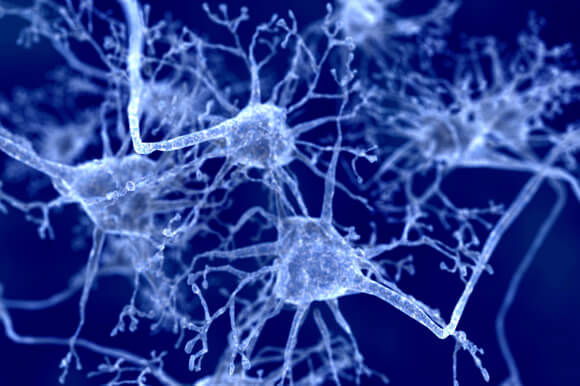In an experiment to study how neurons form networks and compute, Thomas DeMarse, a University of Florida professor of biomedical engineering, says his lab-grown rat “brain” in a dish can fly a simulated F-22 fighter jet via an array of electrodes.
DeMarse grew the 25,000-neuron “brain” in a glass dish. The cells, cortical neurons cultured from a rat brain, sit atop a 60-electrode grid connected to a desktop computer. The neurons then form a two-way connection with the simulator software—much like how our brain gets input from the senses and in return instructs the body how to act.
The simulator sends the neurons information about flight conditions—the plane’s attitude, for example—and the neurons return signals to the plane’s controls to alter its path. The process is repeated in a feedback loop, controlling the plane’s flight.
DeMarse’s experiment delivers an otherwise elusive live glimpse of neurons in action—it’s difficult to observe brains on the cellular level in living animals.
“You see one extend a process, pull it back, extend it out—and it may do that a couple of times, just sampling who’s next to it, until over time the connectivity starts to establish itself,” DeMarse said. “[The brain is] getting its network to the point where it’s a live computation device.”
To get an idea of just what that looks like, watch the below video from a team of University of Illinois scientists. The researchers developed a special method for imaging neurons, like those in DeMarse’s experiment, forming networks.
Although computers can perform brute force, serial calculations at speeds that leave biological brains in the dust, they still struggle to match the brain’s innate ability to recognize patterns and learn from them. Seemingly simple tasks, like recognizing a table and chairs or a face, have proven extraordinarily difficult for computers.
Studies like DeMarse’s may yield insight into how the brain’s pattern recognition works and how we might reverse engineer it. “If we can extract the rules of how these neural networks are doing computations like pattern recognition, we can apply that to create novel computing systems,” DeMarse said.
We might even use neuronal networks as living computers to fly drones or perform operations hazardous to humans in disaster areas or war zones. Scientists further hope to learn more about disorders of the brain and how to treat them.
Other studies are beginning to make progress in creating more realistic lab-grown ‘brains.’ David Kaplan of Tufts University and his team recently showed they could grow long-lived rat neurons in three dimensions that included grey matter (neuron cell bodies) and white matter (axon bundles).
And instead of growing biological neuron networks in the lab, other experiments to better understand brains are modeling them on computers.
Henry Markram’s Blue Brain Project modeled a 10,000-neuron cortical column in a rat brain. And now part of the billion-euro Human Brain Project, Markram and other scientists hope to digitally model an entire human brain inside the next decade.
All these approaches have similar aims—to learn more about how and why disease affects the brain and potentially reverse engineer how biological brains compute to make computers better at difficult problems like pattern recognition.
What’s next? DeMarse and Jose Princip, a distinguished professor of electrical engineering and director of University of Florida’s Computational NeuroEngineering Laboratory, will build a mathematical model of how their neurons compute.
DeMarse says that more advanced applications are a long way off. But quantifying the brain may lift some of the mystery behind how it learns, why it breaks downs, and even eventually, how we might recreate its prodigious powers in silicon.
Learn more about the research at Science Daily, “’Brain’ in a Dish Acts Autopilot, Living Computer.”
Image Credit: Shutterstock.com




